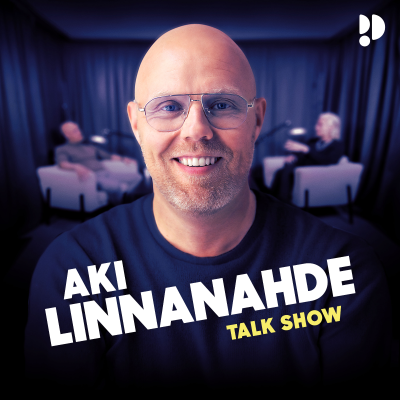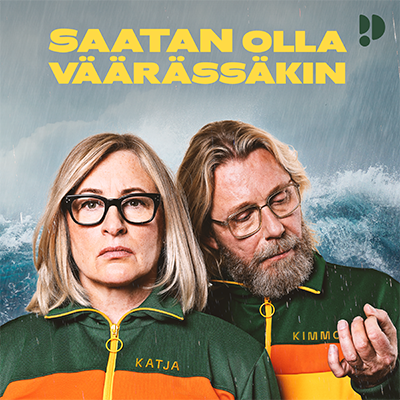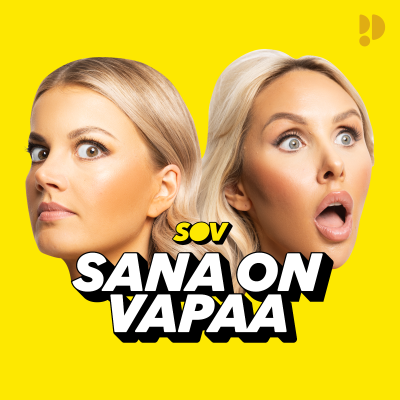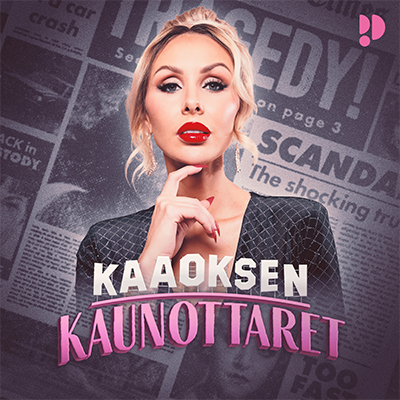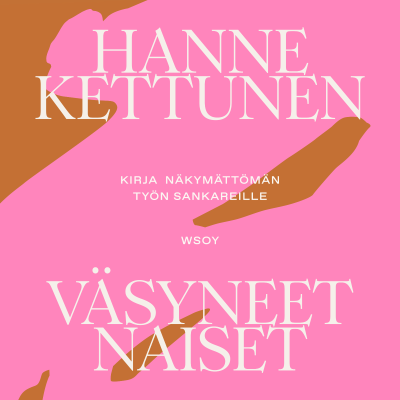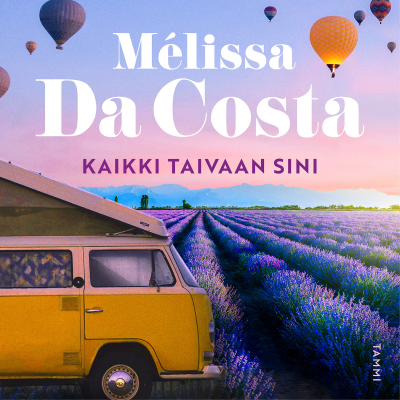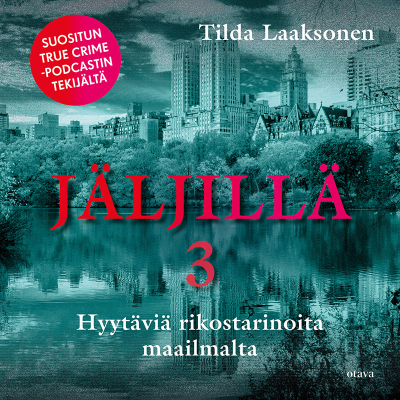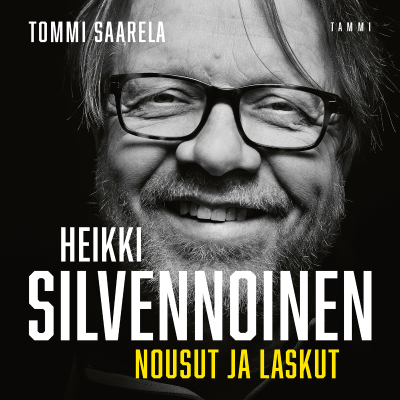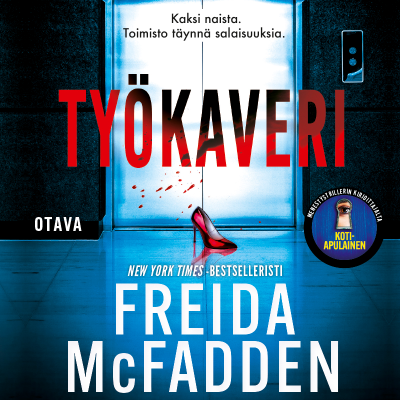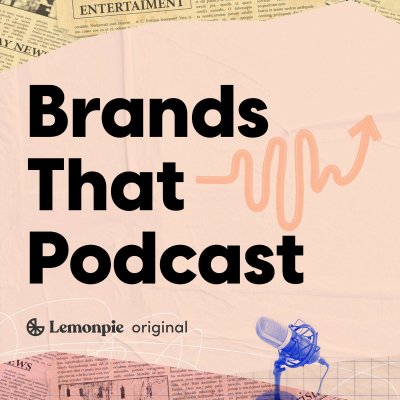
Brands That Podcast
Podcast by Lemonpie
Brands That Podcast is the only podcast in the world sharing case studies, interviews, and stories of how companies are using podcasting (in all of its forms) to grow. If you’re a Founder, CEO, CMO, or VP of Marketing of a brand looking to grow, or you run marketing, PR, or internal communications for those brands...this podcast is your secret weapon. We’ll be showing you how to leverage podcast advertising, branded podcast production, podcast guest appearances, and private podcasts (for your internal teams). Audio is the next platform of consumer attention, and it’s still extremely early days. Your brand has a once-in-a-lifetime opportunity right now to jump into this channel, and we’ll show you how to do it.
Aloita 7 vrk maksuton tilaus
Kokeilun jälkeen 7,99 € / kuukausi.Peru milloin tahansa.
Kaikki jaksot
51 jaksotHey BTP listeners! Claudia here, Lemonpie’s Content Marketing Manager. I hope you enjoyed season 2 of Brands that Podcast and all the incredible guests we had on the show. We are officially wrapped with this season but will be back for more in the future. In the meantime, make sure you follow us @LemonpieFM on LinkedIn, Twitter, and Instagram. And if you’re interested in reaching your audience on podcasts they love, be sure to check out www.lemonpie.fm [https://www.lemonpie.fm/].
In this episode, we talk to Michael Rivo, director of Salesforce Studios, about their incredibly produced show, Blazing Trails, and how they use podcasting to grow their brand. Tune in to learn more about Salesforce crafted its flagship show, how they built a network of shows for different audiences, how they work with their PR team to repurpose podcast content, and so much more. Guest-at-a-Glance Name: Michael Rivo What he does: Director of Salesforce Studio and host of Blazing Trails [https://www.salesforce.com/resources/podcasts/blazing-trails/] Connect with him: LinkedIn [https://www.linkedin.com/in/michaelrivo/] Key Takeaways It all comes down to creating content that brings value to the listeners. The focus of the Blazing Trails podcast is to create content that helps people be better at work. In large organizations, it’s easy to fall into the mentality of thinking about yourself first and falling back on those company talking points. But Michael says it’s important, particularly in an intimate medium like podcasting, to have those conversations be really authentic and centered around how they’re going to help the listener. Take a newsroom approach to planning podcast content. One way the Salesforce team puts episodes together is by topic. They come together as a team, discuss what’s happening in the world, what’s most important, what’s top of mind for their listeners, and then figure out who would be the most interesting person they can bring to cover that topic. Then, they ask themselves, “Who at Salesforce is really tackling this issue? And how can we bring those people together?” It’s a very organic approach. Get your leadership team involved in the podcast. Provide your team a vehicle to have exciting conversations with thought leaders in their space. This will help you expand your network, bring value to the show, and helps foster relationships inside the organization. Salesforce connects directly with their SVPs and leaders in the company, presents them with a podcast topic, and asks who from outside the organization they would want to have a conversation with about that topic. It gives them a say in the content. If you’re going to use your podcast for product announcements, make sure there’s a story behind it. Don’t just think of it as an announcement. Really think about the why. Why is this coming out now? What’s important about it? What does this mean for a listener in another company? Explain the reasoning and story behind the product vs. just how they would use it. You can also bring on guests who believe in the mission of the product, use it regularly, and can talk about how it benefits them. Podcasts are the perfect medium for brands to employ storytelling. In most other marketing situations, you have a few seconds or minutes to grab your audience’s attention. Whether that be with a tweet, a 5-minute blog post, or a short 60-second video. The constraint of other marketing channels is they make it hard to have in-depth conversations. With podcasting, you’re able to be in someone’s ear for 45 minutes and really tell a story from start to finish. Think about your podcast like a Thanksgiving dinner. From one recording (i.e. Thanksgiving meal), there are so many other pieces of content (i.e. dishes) you can create to increase the number of touchpoints you have with your audience. Blog posts, embedded audio clips, audiograms, LinkedIn posts, Twitter threads. And now, with all those pieces of content, you’re better able to see and track the ROI of the podcast. Treat each episode as a content generation center point. Podcasting is a pretty level playing field. Nothing is stopping you from creating a top-level show. Particularly with remote interviews, you can now bring on guests from all over the world. All you need is a strong brand identity, compelling copy, a unique hook, and an interesting guest list. Anyone can do it. You just need to be willing to put in the work and be consistent with it long enough to really build an audience. Successful podcast hosts are not afraid to show their personalities. Your host doesn’t have to be a performer, but they do need to understand they’re creating an intimate relationship with the listener. They should approach it from a journalistic standpoint where they can be really authentic with their personality and are comfortable speaking and facilitating conversations. Interview prep is key. As a host, you need to take a couple of hours to prepare for each interview. You should be comfortable with the topics, the materials, and the guest’s background, and you need to come up with a strong set of questions to guide the conversation. But with the right prep, you’ll also be able to deviate from your list of questions and have a real conversation. Think about yourself as a stand-in for the audience. Less is more when it comes to creating a podcast network. You should only consider adding new shows to your network if the audiences you’re trying to reach really are so different that they need separate shows for each. Michael believes in the less is more approach. There are only so many shows that your ideal listener is going to have in regular rotation. So your best bet is to build up your singular feed and use series or seasons to separate out topics rather than asking them to subscribe to yet another show.
In this episode, we chat with Tim Soulo, CMO at Ahrefs, about the power of podcast sponsorships. Ahrefs is a leading SEO tool with about 75 employees and $100M in annual recurring revenue. Simply put, they’re one of the biggest brands in marketing. Tune in to learn why Ahrefs spent $214K in podcast sponsorships over the course of a year, how they measure ROI outside of direct sales and leads, how they use qualitative attribution, and so much more. Guest-at-a-Glance * Name: Tim Soulo * What he does: Chief Marketing Officer and Product Advisor at Ahrefs [https://ahrefs.com/] * Connect with Tim: LinkedIn [https://www.linkedin.com/in/timsoulo/] | Twitter [https://twitter.com/timsoulo] Key Takeaways If you’re looking to sponsor podcasts, make sure you pick shows with active audiences and credible hosts. Make sure you’re not sponsoring a show with inflated numbers or a host who is simply doing this as a hobby for themselves and their friends. This is crucial to ensuring your sponsored message actually gets in front of the right audience and is worth your investment. Podcast ads help you build brand affinity through the “mere exposure effect”. The “mere exposure effect” is a psychological phenomenon where the more people are exposed to your brand, the more likely they are to develop an affinity for it. When the listener is faced with making a choice between your brand versus one not on their radar, they will choose yours merely due to the fact they heard about you numerous times on a podcast. The best host-read ads come from hosts who’ve used your product. When a host can give a more natural read of your product because they’ve used it themselves, the audience will listen more attentively because they already know and trust the host. Your goal is to partner with hosts who will genuinely recommend your product, regardless of whether you sponsor them or not. Always negotiate sponsorship pricing. Podcast sponsorship pricing is all over the map. The best strategy is to reach out to at least 20 podcasts, gather pricing information, and figure out averages before you commit to anyone. This will help you determine who’s pricing is above standard and who is undercharging so you can negotiate better deals for your brand. Treat download numbers with suspicion. It’s commonly known in the podcast industry that download numbers aren’t the most accurate representation of the number of listens per episode. When you consider sponsoring a show, make sure the host is well known in the industry. Look at their social following to ensure they have a loyal audience versus worrying about their monthly podcast download numbers. Partner on a giveaway with the host in exchange for engagement. You can offer the host a free version of your product to giveaway to their listeners, and in exchange, they can ask listeners to leave reviews or subscribe to their show. Not only will this get you extra air time at no additional cost, but it will increase the attention span of the listeners because they’re getting something of value for free. Sponsor an interview question instead of a host-read ad for a more organic insertion of your brand. Rather than paying for the typical host-read ad at the start, middle, or end of an episode, consider sponsoring an interview question instead. This will give you the opportunity to create a natural plug for your brand within the conversation and won’t break the attention of the listeners. Convert hosts into brand advocates by offering them your product for free. If you’re targeting hosts who are your ideal customers, offer them your tool or product for free for a limited time, help them set it up, and help them understand what it can do for them so they give you a more genuine endorsement on their show and continue to organically talk about you outside of your sponsorship agreement. It pays to pay creators. When you sponsor creators, you form relationships through the process of educating them on your brand. You pay them for their time and for their work, and if your product is good, you essentially turn them into organic fans. Meaning, even after you stop sponsoring them, they will naturally continue talking about you. Think about sponsorships as paying for the creator’s work. In 2022, Ahrefs is investing exclusively in creators versus big advertising companies like Google, Facebook, and Twitter. Their philosophy centers around the idea of paying talented creators for their work, not their loyalty. Rather than investing in brand advocates, think about it as investing in a piece of work that would’ve otherwise not been created. Mentions * Ahrefs Podcast Advertising Lessons Learned Article [https://ahrefs.com/blog/podcast-advertising/] * Ahrefs Podcast Advertising Lessons Learned Video [https://www.youtube.com/watch?v=PKKtHp19GXk]
Today’s guest is Justin Jackson, Co-Founder of Transistor, our favorite podcast hosting platform. In this episode, we talk about ways companies can use podcasting to build a community of supporters. You’ll learn more about the number one metric businesses should be measuring when it comes to their podcast ROI, how critical it is for shows and brands to be transparent, and the different use cases of internal or private podcasting. Guest-at-a-Glance Name: Justin Jackson What he does: Co-founder of Transistor [https://transistor.fm/] and co-host of Build Your SaaS [https://saas.transistor.fm/] Connect with him: Twitter [https://twitter.com/mijustin] | LinkedIn [https://www.linkedin.com/in/justinijackson/] | Website [https://justinjackson.ca/] | YouTube [https://www.youtube.com/justinjackson] | Instagram [https://www.instagram.com/mijustin/] Key Takeaways Podcasting helps you build a community of supporters for your brand. Justin and his business partner, Jon, were able to build a community of supporters for Transistor right from the start through their podcast, Build Your SaaS. They weren’t afraid to address real problems and have hard conversations on the show. Not only did this help them build an authentic community, but it helped them grow as partners. Your audience doesn’t want to listen to a buttoned-up podcast. They want the hero’s journey. They want to see someone struggle and not be there yet because it’s more relatable than a typical corporate podcast where everything is cleaned up and they have it all together. Your audience wants transparency from you. They want to follow along as the hero faces different obstacles and overcomes them. Response rate should be the most important KPI you measure for your podcast. Does anyone actually respond to your show? Are you compelling your audience to take an action? Did anyone care enough to reach out and give you feedback or a review? Did anyone write you an email to tell you how much your podcast helped them? Did anyone tweet about an episode and recommend it to their followers? That’s the best way to measure success, not downloads. Transparency in podcasting isn’t black or white. There’s a spectrum of how transparent you can be about certain situations. You need to be judicious about what you choose to share in a way that serves your audience. For Justin, sharing Transistor’s revenue from the inception of the company worked until they reached about $30K in monthly revenue. After that, the arc of the story passed. They made it from $0 to $30K, and it was no longer advantageous to them or their audience to see their revenue numbers. Most attribution is “dirty”. The reality behind marketing and podcast ROI is most attribution is dirty, meaning it’s incredibly difficult to get right. There’s usually a lot of noise surrounding the tools that track people and their activity, particularly in podcasting where metrics and attribution have challenging history. That’s why Justin prefers measuring success through a simple metric, like response rate. There’s no need to put it in a spreadsheet or track every comment. It’s a simple feeling of the general momentum of your show. Prompt your audience to engage with your podcast. During an episode, use prompts and questions to get your audience to engage with you. You can ask them what they think about a certain portion of the episode and have them email you their thoughts or even tweet them. You can’t expect the audience to act without giving them a reason or asking them to. Have conversations with your audience to gather qualitative data. The only way to turn qualitative data into quantitative is to actually have conversations with your listeners. If you talk to 100 listeners and 85 of them say, “I loved the episode you did on X,” now you have a quantitative metric to show that that particular episode was important. You can then take it a step further and figure out why they thought it was important so you can replicate the success in future episodes. Use internal podcasting for training and onboarding. Justin suggests companies take advantage of internal podcasting by using the platform for training and onboarding. Create a compelling 6-episode series that explains your company, how you got here, what to expect, etc., and share that with every new hire. You can even drip feed the episodes where the employee only gets one episode at a time to really help maintain the storyline. Private podcasts aren’t just for employees. You can use them for customers too. If you could give your best, most important customers an inside look into things you’re working on, what you’re thinking about, what you’re wrestling with, etc., you’re making them feel like they’re an exclusive part of your brand. You can use Transistor for dynamic ad insertions. Rather than having to manually download your episodes, edit them to add a special announcement (e.g. you’re hosting a conference and want to share with your audience), and reupload the episodes, you can now use Transistor’s dynamic ad insertions to set up campaigns. Your announcements/ads will run on all live episodes for whatever specified time you set in the backend, and once it’s done, the ads are automatically removed from all episodes. Mentions * Bootstrapped Web Podcast [https://bootstrappedweb.com/] * The Art of Product Podcast [https://artofproductpodcast.com/] * How I Built This: Patagonia [https://podcasts.apple.com/us/podcast/patagonia-yvon-chouinard/id1150510297?i=1000378841890]
In this week’s episode, we talk with the host, writer, and producer of This is Purdue, Kate Young, about why a university like Purdue would start a podcast. You’ll hear how they measure success, what their goals are with the podcast, how it impacts growth at the university, and how they grew to 116,000 listeners in 2021. Guest-at-a-Glance Name: Kate Young What she does: Host, writer, and producer of the This is Purdue [https://stories.purdue.edu/podcast/] podcast Connect with her: LinkedIn [https://www.linkedin.com/in/kate-young-podcast/] Key Takeaways Use YouTube as a way to grow your podcast. Don’t forget about YouTube when it comes to sharing your podcast. Particularly, if you record video versions of your episodes. The Purdue team uses a mix of organic and paid strategies to boost their podcast views by taking an entire 40-minute interview, optimizing the titles and descriptions, and also uploading the audio version of the podcast using Wavve or Headliner. They’ve seen a 195% increase in downloads using this strategy. Podcasting allows you to tell a more personal story. Purdue uses their podcast as a pure brand play. Rather than writing these stories, they bring on faculty, alumni, and students so listeners can hear these stories directly from the voices making an impact on their school. Not only does this create a sense of community within students, but it also connects alumni and faculty back to their alma mater. You can reach older alumni by sharing the podcast RSS feed on Facebook. Some of the older alumni might not be as familiar with podcasts or podcast apps. So in order to reach that audience, the Purdue team connects the podcast’s RSS feed to Facebook so people can listen directly from that platform. YouTube would be another great way to reach an audience who might be less likely to subscribe to a podcast but are more likely to subscribe to a YouTube channel. It’s important to repurpose each episode into digestible social content. Purdue shares everything from audiograms and TikToks to short video clips and quote graphics for every episode they publish. Because this is their official university podcast, the marketing and communications teams are able to manage the show from start to finish, meaning the branding is consistent throughout, and social content is created on a regular basis. This helps their audience grow on all platforms. Work hand-in-hand with your PR team to cross-promote your podcast episodes. When pitching to media outlets, Purdue’s PR team embeds any relevant podcast clips into their articles to provide an audio version of the story they’re trying to tell. Not only does this give the reader and media outlets a more personal perspective on the story, but it also increases your podcast reach and downloads. Growth can explode when guests share your show. It’s important to give your guests a nicely packaged set of assets they can use to promote your podcast episodes. This should include graphics, videos, show notes, and even social copy. Make it as easy as possible for them to share your content in order to increase your podcast’s reach within their audience. The ultimate success metric is getting positive podcast feedback from people outside the Purdue community. When Kate hears compliments on Purdue’s podcast from people who went to other schools (even rival schools), that’s when she knows the show is a true success. Those people aren’t tied to Purdue, they didn’t drink the Kool-Aid, yet they still enjoy listening to the podcast and find value in it. That’s the ultimate goal and measure of success. It’s not too late to start a podcast. It may seem like there’s an overabundance of podcasts out there and your window to start a new one may be closing. But Kate mentioned out of the millions of podcasts in production, only 322,000 are active. Many people and brands realize how much work goes into creating and sustaining a show and give up after a season, or even after 10 episodes. So if you’re thinking of getting into podcasting as a marketing or brand play, know that it’s not too late. Having 100 people listen to your podcast for 30 minutes is more impactful than 500 website impressions. The power of audio is undeniable. Having 100 people listen to your branded podcast content for 30 to 45 minutes and truly immersing themselves in your brand has a much larger emotional impact than 500 website visits. A podcast allows listeners to spend quality time with your brand, which is incomparable to a 2-minute article read. This allows you to build trust and brand affinity. Mentions * Riverside [https://riverside.fm/] * Descript [https://www.descript.com/] * Wavve [https://wavve.co/] * Headliner [https://www.headliner.app/]
Aloita 7 vrk maksuton tilaus
Kokeilun jälkeen 7,99 € / kuukausi.Peru milloin tahansa.
Podimon podcastit
Mainoksista vapaa
Maksuttomat podcastit




